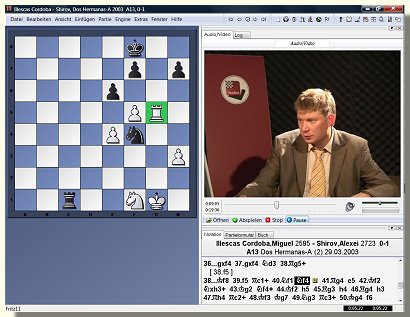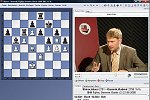Alexei Shirov:
Endgame fireworks
Review by GM Hedinn Steingrimsson
Alexei Shirov presents the most interesting endgames that he has played. The main emphasis is on the practical side of endgame play. In a typically for him honest manner Shirov confesses that he does not know much about theoretical endgames and that he has not spent much time on trying to learn all the theoretical positions there are. This nevertheless does not prevent him from playing very strongly in the endgame and in fact it seems that in some cases his opponents make the mistake of trying to reach a theoretical position instead of playing the position on the board in an optimal way. Such an academic approach in a practical game often fails because of small nuances that in the end make all the difference between e.g. a draw and a win. Shirov shows that precise calculation and non-dogmatic approach can in fact be better than trying to remember theoretical endgames and play with the goal of reaching such a position.

The type of endgames presented is pretty broad. First there is a couple of opposite coloured bishop endings among others the famous Topalov-Shirov ending where Shirov played the amazing kamikaze like move …Bh3!!. Shirov explains how he learned about this theme from the opposite site of the table in his game with Ulf Anderson. This theme interestingly seems to occur rather frequently in pure opposite bishop endgames. Then there come endings with two rooks against Michael Adams, Alexei Dreev and Andrey Volokitin, where initiative and attacking chances are very important. After that there is one endgame, against Peter Heine Nielsen, with one rook. Here Nielsen “almost” reaches a theoretically drawn position, but because of certain nuances and specifics of the positions Shirov can nevertheless win. There is one endgame, against Miguel Illescas with rook and knight against rook and knight where Zugzwang and activity of the rook plays a big role.

One or two rooks and opposite colour bishops can be regarded the main theme of this DVD. In these endings the initiative is of special importance and therefore it is not covered so extensively in current endgame literature which tends to focus on rather static positions. First there are two games against Joel Lautier presented, then games against Kramnik, Karjakin, Vyzmanavin.
Click here
for replay the start of Shirov-Karjakin.
Lautier was much better in both games, some pawns up and almost winning, but in the end Shirov managed in both games to take over the initiative and turn the table. One of these games was a real eye opener for Shirov, because it made him understand that a rook and a bishop can with the help of the king create very serious mating threats to the opponent’s king.
Then there are more traditional endings where Shirov has a rook and bishop against Ivan Sokolovs rook and knight and one against Rublevsky where each side has two rooks and same colour bishop.

After that there are pawn endings against Akopian and Timman and finally the theoretical ending with rook and bishop against two knights and without any pawns which occurred in Shirovs game against Karjakin and Shirov presented in his Sveshnikov DVD.
The bottom line
It is save to say that this DVD fills a certain gap in the chess literature. Most work dealing with endgames has focused on presenting theoretical endgame positions of rather static nature. It is the nature of chess that there are practically unlimited number of different positions, also endgame positions, and each one has its special characteristics and nuances. Instead of trying to smooth these differences and form the game into a previously known direction, Shirovs approach is to welcome these differences and try to make the most of his chances using calculation and independent thought. This approach has proven its validility in Shirovs practical games.
This DVD gets 4.5 out of 5 possible stars. Shirov presents endgame play in a very lively, undogmatic and honest way which practical players of all levels can learn a lot from.



























